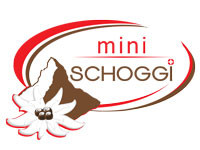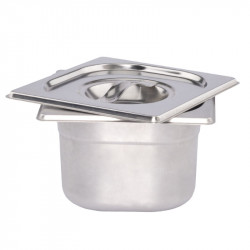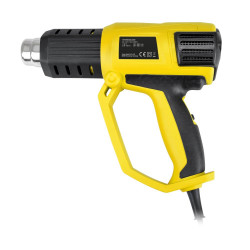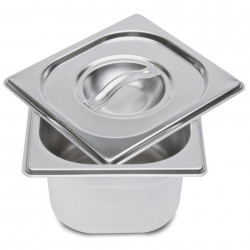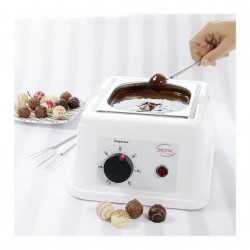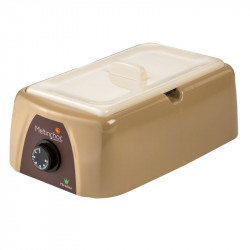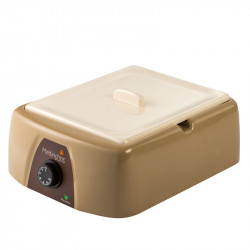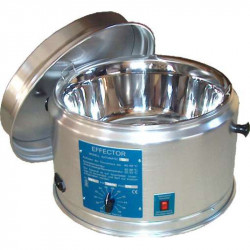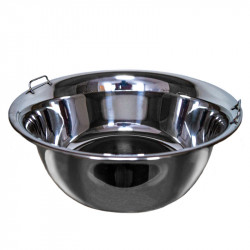A Mail deliveries
Order by 4 pm = delivery the next working day.
Free delivery
From CHF 100 purchase
-
MenuBack
-
Online Store
-
-
-
- Couverture
- Temperature control units
- Aids for chocolate
- Chocolate molds
- Praline fillings
- Chocolate ingredients
- Praline hollow body
- Chocolate colors
- Chocolate tattoos
- Chocolate packaging
- Bean to Bar
- Material for cutting chocolates
- Batons with Kirsch
- Airbrush for chocolate
- High Heels Accessories
- Textured films for chocolate
- Chocolate fountain & fondue
-
-
-
-
-
- Cakes Fillings & Ingredients
- Fondant & Marzipan
- Cakes tools
- Cake rings
- Silicone molds
- Decorative mats
- Baking pans for cakes
- Cake stand
- Cakes packaging
- Airbrush for cakes
- Sugar flowers accessories
- Cake Topper & Wedding Figurines
- Cakes dummies
-
-
-
-
-
-
-
-
-
-
-
-
-
-
-
-
-
-
-
-
-
-
-
- Baking chocolate
- Glucose & Sorbitol
- Cocoa beans
- Cocoa nibs
- Monin syrup
- Champagne & Alcohols
- Freeze dried fruits
- Cake & cake glaze
- Flours & baking ingredients
- Chocolate coating & chocolate
- Milk powder
- Granules
- Nuts & Nougat
- Fruit puree
- Creams & Fillings
- Egg yolk & egg white
- Fruit powder
- Special ingredients
- Fondant & Flower Paste
-
-
-
-
-
-
-
- Punching, cutting & embossing
- Mixing bowls & whisks
- Chocolate material
- Thermometer & Burner
- Gloves & Protective Material
- Smoothing & Modeling
- Roll out bar
- Dough scraper & horn
- (Flour) sieves
- Brushes & Tweezers
- Cake turntable
- Spatula & Spatula
- Silicone embossing molds
- Insert strips & cake slices
- Measuring cup
-
-
-
-
-
-
-
-
-
-
-
-
-
-
-
Schablonen & Stencils
-
-
-
-
-
-
-
-
-
-
-
Courses
-
-
- Current courses
- Praline courses
- Chocolate courses
- Chocolate kiss course
- Macaron courses
- Cake courses
- Baking courses
- Patisserie courses
- Ice cream course
- Guetzli, Cookie & Confectionery Courses
- Bread courses
- Pasta courses
- Apéro course
- Cooking courses
- Cupcakes courses
- Éclair course
- Courses in Zurich - Adliswil
- Children's courses
-
-
- Team Events
- Hen Night
- Retail Store
-
About Us
-
-
-
DirectionsDownload relevant PDF now.
-
-
-
Recipes blog
-
-
Recipes Blog
-
-
-
Shipping and Payment
-
- Online Shop
-
- Novelties
- Sale
- Gifts Cards
- Stencils & Stencils
- Chocolate and pralines
- Couverture
- Temperature control units
- Aids for chocolate
- Chocolate molds
- Praline fillings
- Chocolate ingredients
- Praline hollow body
- Chocolate colors
- Chocolate tattoos
- Chocolate packaging
- Bean to Bar
- Material for cutting chocolates
- Batons with Kirsch
- Airbrush for chocolate
- High Heels Accessories
- Textured films for chocolate
- Chocolate fountain & fondue
- Couverture
- Cakes & Pies
- Ice cream
- Bread
- Macarons
- Hearty
- Recipe booklets & books
- Cupcakes
- Dessert
- Cake Pops
- Edible decorations
- Fillings & Ingredients
- Glucose & Sorbitol
- Cocoa beans
- Baking chocolate
- Cocoa nibs
- Monin syrup
- Champagne & Alcohols
- Freeze dried fruits
- Cake & cake glaze
- Milk powder
- Flours & baking ingredients
- Chocolate coating & chocolate
- Granules
- Nuts & Nougat
- Fruit puree
- Creams & Fillings
- Egg yolk & egg white
- Fruit powder
- Special ingredients
- Fondant & Flower Paste
- Food Colors
- Auxiliary means
- Spouts & piping bags
- Fondant, marzipan, flower paste
- Bakeware
- Aprons & Potholders
- Cookie cutters
- Season
- Candles
- Party accessories
- Cocktail
- Cookie & cookie tins
- Tableware
Temperature control units
There are 16 products.
Active filters
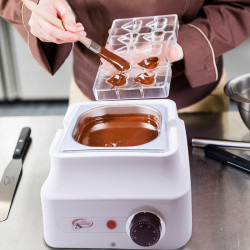
miniSchoggi tempering device for couverture and chocolate
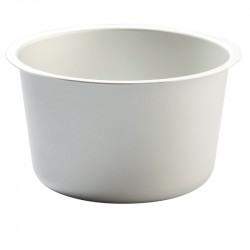
Additional container for temperature control unit round, 1.8 liters
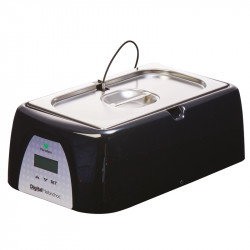
Temperature control unit digital, 3.6 liters, professional quality
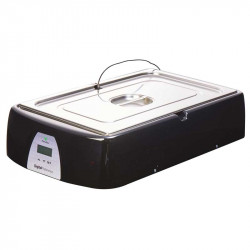
Digital temperature control unit, 13.7 liters, professional quality
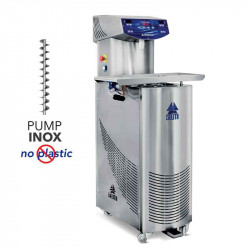
Selmi automatic professional tempering machine for chocolate
- Out-of-Stock
When do you need a temperature control unit?
We recommend using a tempering device when processing couverture / chocolate coating because it is simply incredibly practical. However, the frequency of use should also be taken into account. If very little tempered couverture is only needed once or twice a year, it is often not worth buying your own tempering unit. For small quantities and infrequent use, it is therefore advisable to melt the drops in a bain-marie.
However, even if you use it regularly for medium-sized quantities, for example during the Christmas period, or if you want to process a lot of chocolate several times a year, a tempering unit is definitely worthwhile. The time you save by using a tempering unit pays for itself quickly.
Nowadays, a wide range of different temperature control units are available. Cheaper, small household temperature control units are already available at a price of just under CHF 100. These are perfect for hobby use at home as they are small, compact and inexpensive.
In addition, there are of course various more expensive temperature control units on the market that have different liter volumes. What you should always bear in mind with a temperature control unit is that the actual temperature control process is not completed, but merely facilitated by maintaining the correct temperature. This means that with normal temperature control units, the desired number of degrees (from 0 to 60 °C) can be set. The appliance melts the drops to the set temperature with a deviation of 1 to 2 °C. As it does not usually have an integrated thermometer, the temperature estimate of the mass is not entirely accurate. It also does not ensure optimum fat crystal formation. Therefore, it should not be expected that if the temperature control unit is set to 32 °C, the couverture mass will be perfectly tempered and ready for further processing. It is merely easier to maintain the desired temperature, making constant reheating unnecessary. In order to ensure that the mixture is at the correct temperature, it is recommended that most appliances, such as Städter's or our own, are checked with a thermometer from time to time. This allows the temperature to be determined and set to the exact degree, especially when changing, and remeasuring is then hardly necessary when keeping warm, but can be used to check after a break, for example.
Automatic temperature control machines are an exception. This appliance covers the entire tempering process from melting at 45 °C to cooling down to 26 to 28 °C and reheating to the correct final temperature of 28 to 32 °C. The fully automatic tempering unit is not cheap, but it saves you a lot of time and always ensures shiny end products. Most patisseries and confectioneries nowadays have such a device in operation for daily use.
The use of high-quality couverture is particularly important. You can find a selection of different top manufacturers and varieties in our store. Unfortunately, even the best tempering is useless if conventional chocolate bars from the supermarket are used.
What are the advantages and disadvantages of temperature control units compared to a water bath?
Advantages
As you don't have to be present during the melting process, you can use your time for other things. It can also be done overnight so that you can start inoculating the next day and soon start processing. The power consumption of the melter is low, but if you don't want to leave it running all night long, you can easily connect it to a timer.
The biggest advantage of a temperature control unit is certainly that you don't have to worry about the mixture becoming too cold or too hot, as the temperature control unit maintains the desired temperature in the stainless steel container. This also allows you to take a lunch or coffee break during production without the mass losing its heat during this time.
There is also no need for a water bath and therefore no water. This reduces the risk of small accidents, such as a little water sloshing into the bowl. Unfortunately, the chocolate then immediately becomes lumpy and unusable for pure chocolate products.
The capacity of the appliances can be used perfectly for different requirements if selected correctly to begin with. Whether you just want to produce a decoration made of dark chocolate or a whole series of chocolate bars, even small amounts are reliably brought to the right processing temperature and with the maximum filling quantity you can also succeed with larger projects.
Disadvantages
Prices for a temperature control appliance start at CHF 95, making them one of the more expensive kitchen appliances that are nevertheless often not in daily use. It also takes up space in the cupboard when not in use. In addition, the work itself remains the same and there is no guarantee that the tempering will be successful, only that the attendance time is shortened and the temperature is kept stable. Melting also takes a little longer, as it is done particularly gently. However, this can easily be avoided by switching on overnight.
How is a tempering device used to temper couverture?
Various tempering methods can be used with the tempering unit, such as inoculation with cocoa butter or tabulation. However, we recommend using the inoculation method for the sake of simplicity and safety.
To do this, melt 2/3 of the desired final quantity of couverture drops to 42-45 degrees Celsius. It must not get any hotter, otherwise the chocolate will burn and form lumps, in which case it is still suitable for cakes, for example.
Once the mixture is warm enough, add the remaining third and stir in. While the pieces are dissolving, the temperature should drop to 26-28 degrees. Once this has been reached, everything is reheated to 28-32 degrees. The temperature depends on the mixture. White chocolate needs around 27 to 28 degrees, milk chocolate is perfect at 30-31°C and for black chocolate it should be 31 to 32 degrees. The mass has then reached its processing temperature. Before doing this, however, we advise you to check that everything has worked as desired.
How can I see whether the couverture is at the correct temperature?
As soon as the couverture mixture has been tempered, a test should always be carried out before starting production. If you know how to read it correctly, you can use this method to find any problems and rectify them.
Make a test by briefly dipping a spatula or small knife into the tempered mixture and leave to set at room temperature for 5 to 10 minutes. Then press firmly on the solidified drop of couverture. If the surface of the sample has a nice shine, is completely firm and your fingerprint is clearly visible after pressing on it, the couverture is ready for further processing.
If something doesn't seem right, if the sample doesn't pick up, gray spots or a haze appear, we advise you to consult our blog. There you will find an article on possible errors during tempering, and you can use a sample to easily check which error could be to blame.
How do you clean the tempering device after melting chocolate?
Cleaning the smaller tempering appliances is very simple. The removable melting containers and lids are usually made of stainless steel and are therefore dishwasher-safe, so they can be cleaned by hand or in the dishwasher with a little washing-up liquid after the chocolate has been poured out. The plastic or metal housing can simply be wiped clean with a damp cloth. It should not be washed due to the electronics it contains. If there is a risk of major soiling, for example if children or many people are working on it at the same time, you can also place some cling film over the exposed parts of the housing beforehand and clamp it lightly under the container. After production, you can then unwind the dripping and smeared film directly.
Cleaning is more complex with the large, fully automatic temperature control unit, but also needs to be carried out less frequently. You will find everything you need to know about this with the product and it will be explained to you when you make your purchase.
How many liters should the container be able to hold?
The right size naturally depends entirely on your needs. For hobby chocolatiers and those working with small quantities of chocolate, 1.5 liters is perfectly adequate. You can easily melt 300-1200 grams of chocolate with this. This is enough, for example, for making chocolate gifts for the family, for decorating pastries such as éclairs and choux, for depositing a few medium-sized hollow figures or for depositing and closing several praline molds.
If you have a small sales production at home or if you like to make lots of large chocolate bunnies for Easter, then you should choose an appliance with 3 to 6 liters. Many of our courses use one of these, so you can make quite a lot with it. Finally, for really large productions, there are professional tempering machines with a capacity of 9 to 14 liters. These are of course more expensive, but offer improved temperature control thanks to the integrated thermostat and of course much more space. Equipped with an additional depositing unit, depositing molded chocolates is made much easier.
The crème de la crème is the automatic tempering machine, which is used in confectioneries or professional chocolate production. In addition to automated tempering, this also offers other conveniences, such as an attachable vibrating table. This allows you to coat cut chocolates and place them on it, while the excess chocolate flows off the praline and back into the rest of the mass. So that you can make full use of all the functions of the professional tempering machine, the manufacturer will provide training on how to use it when you order the machine.
